Fortnite is one of the most successful video games in history, and this success fascinates and confuses many people who have made efforts to account for how a game could have become such a phenomenon so quickly. As the former Director of User Experience (UX) at Epic Games, where I worked on Fortnite from 2013 to late 2017, I would like to share the different steps that were taken by the Fortnite team to build what would later become the phenomenon we now know, through the lens of UX. My background in psychology, my occupation as a UX strategist, and my personal work on the game likely bias my perspective since we are all susceptible to unconscious biases. However, this analysis, unlike those that have been proposed thus far, is a firsthand account that was presented in several Game Developers Conference (GDC) talks that I gave before Fortnite was released, and in my book The Gamer’s Brain: How Neuroscience and UX Can Impact Video Game Design (2017).
The Fortnite team had a precise vision and collaborated very closely with the UX team to deliver a game that would be true to this vision and that would appeal to many different types of players. My contention is that the success of Fortnite is linked to their efforts in adopting a UX mindset. My goal here is to explain how to develop such a game UX mindset and build a UX strategy to help game developers around the world find success more quickly with the games they are crafting. This is especially crucial for independent developers who have fewer resources yet still compete with the thousands of games released every year.
I will detail here the three most important steps to develop a game UX mindset, which were taken during the development of Fortnite:
Understanding the player’s brain
Following a game UX framework (guidelines to usability and engage-ability)
Applying the scientific method & establishing a UX pipeline
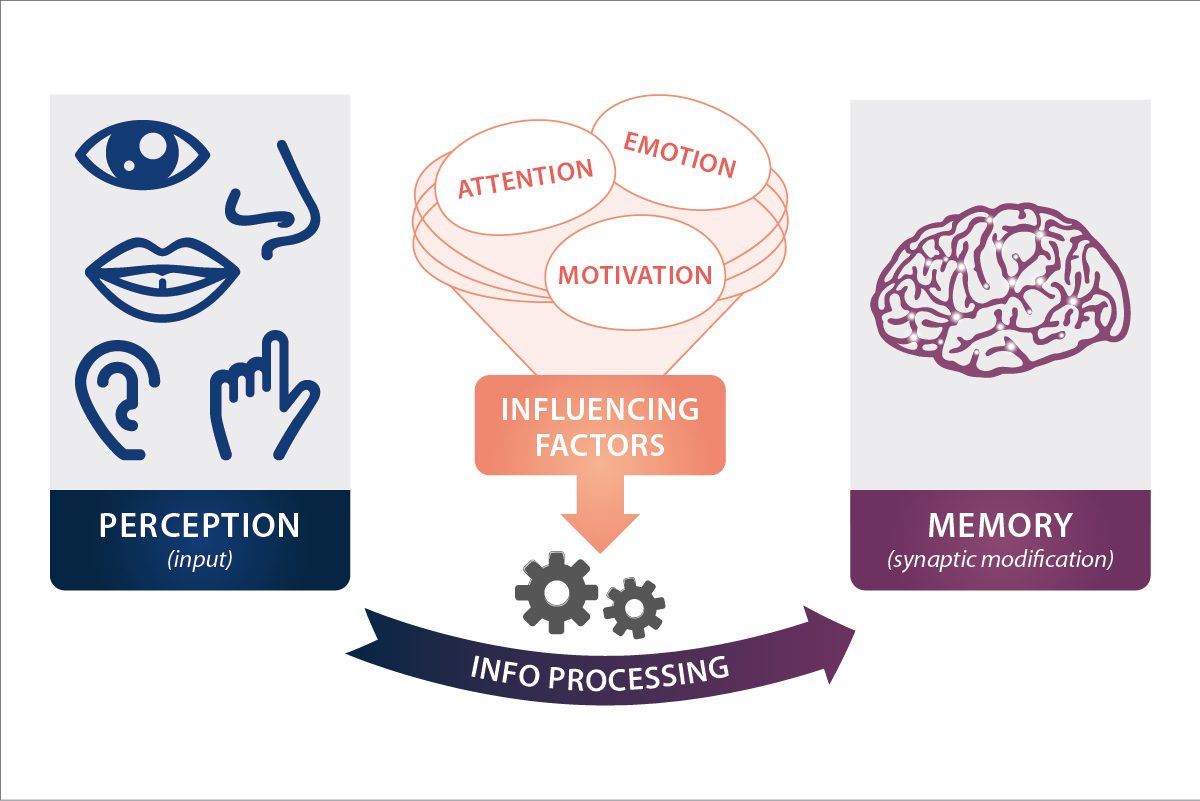
Simplified diagram showing how the brain learns
Simplified diagram showing how the brain learns
UNDERSTANDING THE GAMER’S BRAIN
This success story narrated through the lens of UX starts by understanding how the brain operates. Discovering and experiencing a video game, like anything else, happens in people’s minds. Thus, to anticipate how players will experience a game, it is critical to know the main capabilities and limitations of our brains. The study of mental processes (such as attention or memory) is called cognitive science. The diagram above shows a simplified version of what is going on in our brains when we learn or process information.
This process starts with the perception of an input (for example, a tutorial text) and as we process the information conveyed by our many senses (we have way more than five), our memory is likely to change. When we learn something, new synapses — the connections between neurons — are created or are strengthened. Everything you do in life — reading a book, watching a movie, chatting with friends, reading this article, etc. — is going to “rewire” your brain, because our brains are not hardwired in the first place. The brain is malleable, and thanks to this plasticity, we are capable of adapting to our ever-changing environment. Between the perception of a stimulus and the modification of our memory, a lot of things happen. Notably, the quality of learning will be affected by many factors, such as our attention, motivation, and emotion.
How much people pay attention when they process information is a critical factor to the quality of learning or retaining that information. The more you pay attention, the better you will process and retain what is going on around you. For each of these mental processes — perception, memory, and attention — I will explain our main limitations, and how we accounted for these limitations during the development of Fortnite. Keep in mind that the brain is extremely complex. We do not have independent linear channels that process our surroundings as shown in the diagram. It’s not even a process. We use a lot of terms from computers to explain how the brain works because computers offer a compelling metaphor, but the brain does not work like a computer. It is much more complex, and scientists are only just starting to understand how it works. I’m going to briefly explain the main limitations for these mental processes, but you can read more about this in this transcript of my GDC 2015 talk.
Perception
Perception is a construct of the mind, and one that is subjective. Take a look at the picture below. What do you perceive here? Color stripes? Maybe people? How about Street Fighter characters? Depending on your knowledge about this game, and even your personal connection to it, you are not going to perceive this input in the same way. And if you are colorblind, like about 8% of the male population, you rightfully feel excluded from my example (please accept my apologies!). No matter what we are designing, we need to make our product or system accessible for everyone; this is why, for example, we should never convey information exclusively through color.
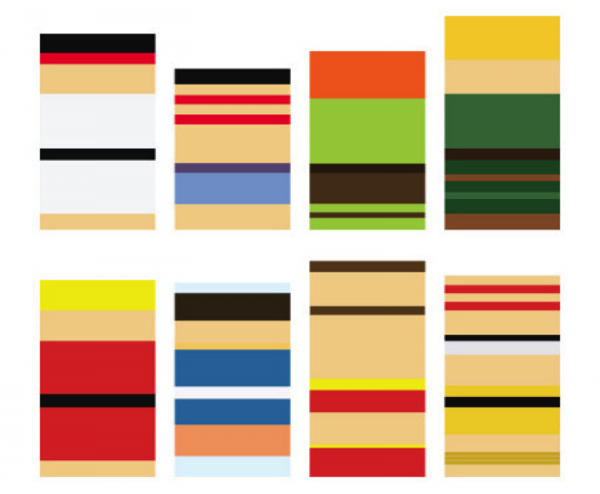
Street Fighter II characters as minimalized by artist Ashley Browning
Street Fighter II characters as minimalized by artist Ashley Browning
Perception is subjective. It depends on our DNA, our prior knowledge, our expectations, our culture, the context, and many other factors. This situation is problematic when we make a video game, because the game represents a series of stimuli that we want players to perceive the way we intended. If perception is subjective, how can we be sure that all the visual and audio cues in a game will be perceived as intended? To put it simply, we cannot. This is why it is very important to run UX tests, whereby we invite people from our target audience to test the game in development. Many types of tests exist, but to determine if our audience perceived the main elements of Fortnite as intended we mainly used surveys. For example, in 2013, we invited a few people to play through a prototype of the game, and then we asked them to tell us what they believed the icons were communicating. The original symbol that was chosen to represent traps in the game was not perceived as such by all players who tested the game then. Some players thought it looked like ammunition, or trees. Thus, the icon was perceived differently by the person who designed it and by the target audience who interacted with it, as I explained in my GDC Europe 2014 talk. As traps were a key feature in Fortnite, it was important to tweak this icon so that no player would be confused by this stimulus. After the UX test, we decided to change the trap icon to look like a bear trap. There are no bear traps in Fortnite, but in our continued testing, all the players we invited to test the game understood the new symbol. This situation underscores that people will have multiple perceptions for any given reality. This situation necessitates testing the main elements in a game, whether they are UI elements, character design, sound design, visual effects, or environment design.
Trap icon iteration (GDC Europe 2014)
Trap icon iteration (GDC Europe 2014)
Memory
Memory is another important component to account for. We are able to memorize a lot of information, and sometimes for a very long time. However, we also forget many things. In the late 18th century, the German psychologist Herman Ebbinghaus uncovered the exponential nature of forgetting. He established the now famous “forgetting curve“. To come up with this curve, he taught himself a list of syllables that didn’t have any meaning (to avoid any familiarity effect) and he varied the time in which he had to recall them all. The figure below illustrates what he found: once he knew the list of syllables by heart, if he recalled them immediately after he had 100% success rate.
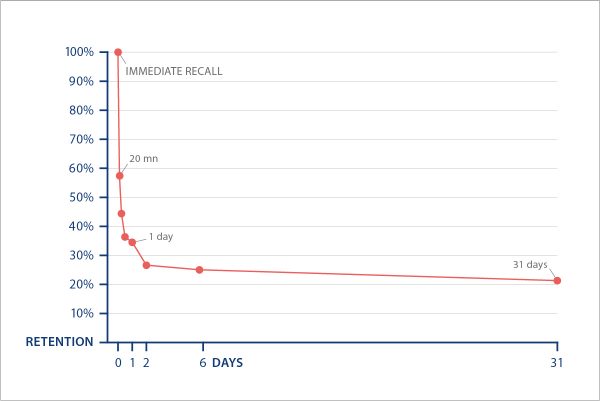
The Forgetting Curve (Herman Ebbinghaus, 1885)
The Forgetting Curve (Herman Ebbinghaus, 1885)
After only 19 minutes, his success rate dropped down to about 60%, and after one day it dropped down to nearly 30%. This means that when you learn something that is not meaningful, and with no method of any kind, you are likely to lose about 70% of the content learned from one day to the next. This is pretty inconvenient, especially for video games since they are usually experienced over several days, sometimes weeks, or even months or years. Given that the human memory is limited, and that we are bound to forget many things, how can we ensure that returning players are not going to forget key information over time? Game developers apply many tactics to avoid this caveat, from repeating information to displaying contextual tutorial tips. However, the most efficient methodology to avoid the impact of the forgetting curve is to reduce the memory load in the first place. The more information is always available to players, the less there is to learn and remember, which underscores the importance of having a good heads-up display (HUD).
The HUD prevents players from remembering elements, such as what gun or abilities they have equipped, how much ammunition they have, or what their next objective is. In Fortnite, a lot of information is always displayed, such as what key to press to search an item. Players do not have to remember this information; it always pops up in the UI for them. Another example is the option for players to pin a recipe they are interested in crafting in their HUD. They do not have to remember what ingredients they need to harvest; they can simply concentrate on their objectives. Our memory is fallible. It can sometimes be very frustrating to come back to a game and not remember the controls, objectives, or how certain systems work. Alleviating players’ memory load is thus important to ensure that they won’t quit a game because they don’t remember some critical information to have fun.
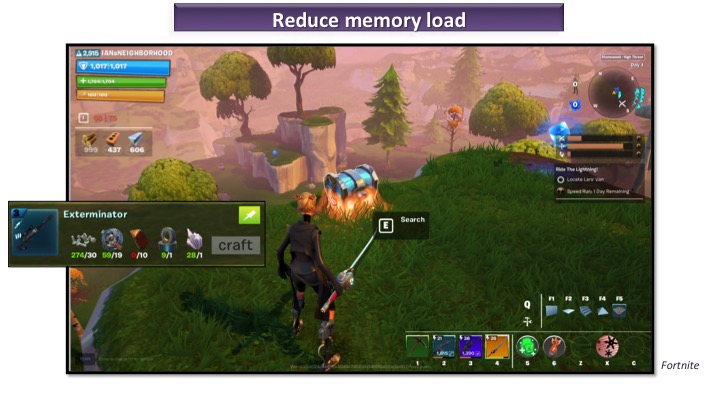
The HUD helps reduce the memory load
The HUD helps reduce the memory load
Attention
Finally, let’s talk about attention. Although we believe that we are good in analyzing our surroundings, we actually have pretty limited attentional resources. We are not able to carefully scan what’s going on around us. Rather, our attention works like a spotlight: we direct our attention to something in particular while we filter out other stimuli. Just like when you’re in a loud bar and you concentrate on only listening to what your friends are saying. This means that we cannot efficiently multitask, despite most of us believing that we can. When we try to multitask, we are missing a lot of information and we make mistakes, even though we might not realize it.
Watch this video for example:
Did you notice something surprising in the video? Most people don’t. This is what we call “inattentional blindness” in psychology and it’s a very powerful phenomenon: when we are focused on a task, we fail to notice stimuli that are not related to the task (even when a very surprising event happens!). Many games challenge players’ attention, which is fine once players master the game. However, asking players to multitask as they are discovering and learning about a game can lead them to miss out on important information. This is why it’s critical, for example, to avoid tutorial text about how to regenerate health as players are combating zombies. At best, players are going to be annoyed by the distraction; at worst, they won’t be able to realize that some information has popped up, let alone process and remember it. Since our attentional resources are scarce, game developers need to mind the cognitive load they put on players at any time, and more specifically when players are learning about something new, as this requires even more attention.
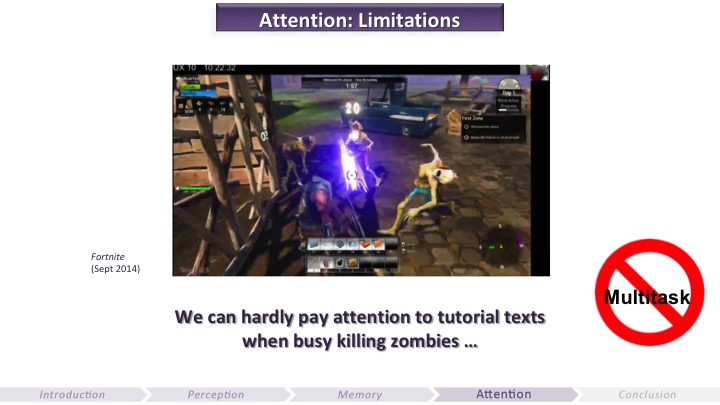
The myth of multitasking (GDC 2015)
The myth of multitasking (GDC 2015)
In summary, when we learn and process information our perception is subjective, our attention is scarce, and our memory is fallible. This is why having a UX mindset, which places the end users at the center of the development process, is key to offering the intended experience.
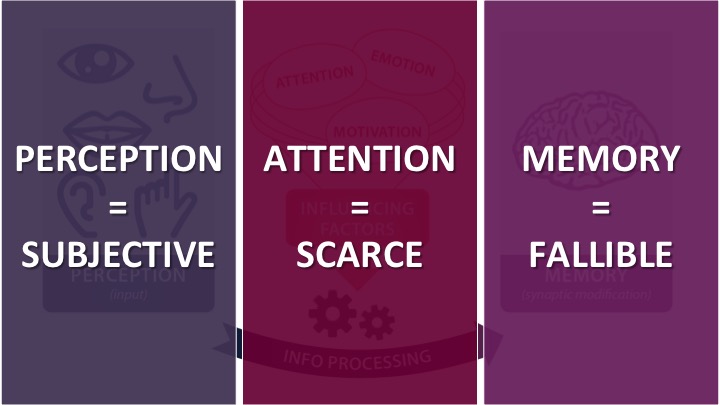
The main limitations of the human brain
The main limitations of the human brain
A GAME UX FRAMEWORK
User experience is a term coined by Don Norman (former Vice President at Apple, author of the renown The Design of Everyday Things, 2013) in the 1990s to account for the whole experience the user is having with a product, system, or service: from the first time they hear about it, to when they buy or download it, when they interact with it, and what they later remember about it. Here we are going to focus exclusively on when players interact with the game. In an effort to anticipate all the frustrations that players can have with the game that aren’t by design, while offering the most engaging and fun experience, we use two main UX pillars in games: “usability”, and what I call “engage-ability”.
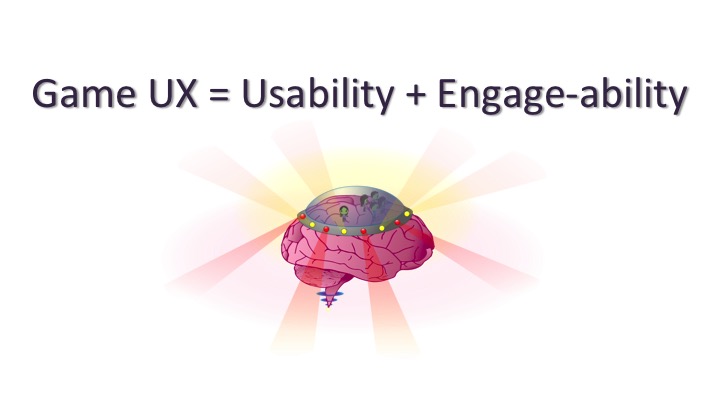
Game UX = Usability + Engage-ability
Game UX = Usability + Engage-ability



































